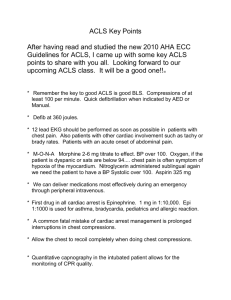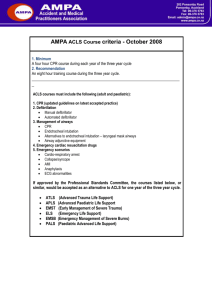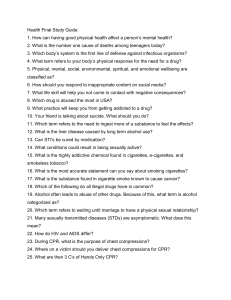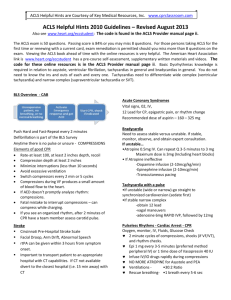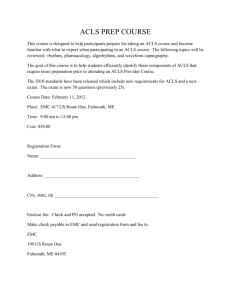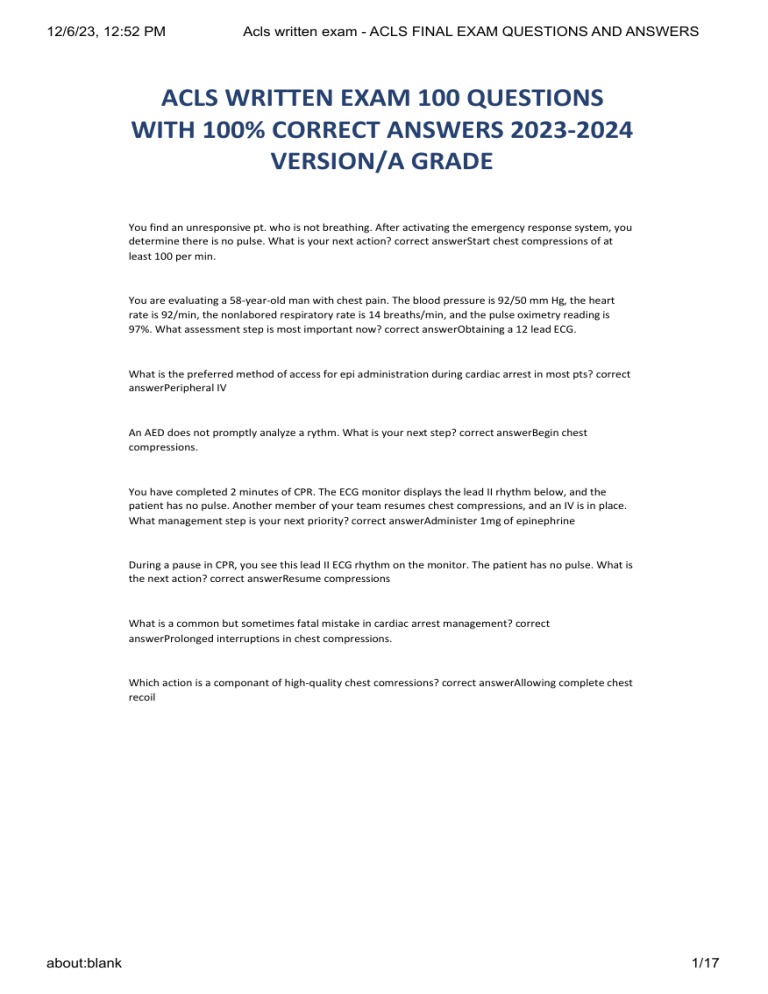
12/6/23, 12:52 PM Acls written exam - ACLS FINAL EXAM QUESTIONS AND ANSWERS ACLS WRITTEN EXAM 100 QUESTIONS WITH 100% CORRECT ANSWERS 2023-2024 VERSION/A GRADE You find an unresponsive pt. who is not breathing. After activating the emergency response system, you determine there is no pulse. What is your next action? correct answerStart chest compressions of at least 100 per min. You are evaluating a 58-year-old man with chest pain. The blood pressure is 92/50 mm Hg, the heart rate is 92/min, the nonlabored respiratory rate is 14 breaths/min, and the pulse oximetry reading is 97%. What assessment step is most important now? correct answerObtaining a 12 lead ECG. What is the preferred method of access for epi administration during cardiac arrest in most pts? correct answerPeripheral IV An AED does not promptly analyze a rythm. What is your next step? correct answerBegin chest compressions. You have completed 2 minutes of CPR. The ECG monitor displays the lead II rhythm below, and the patient has no pulse. Another member of your team resumes chest compressions, and an IV is in place. What management step is your next priority? correct answerAdminister 1mg of epinephrine During a pause in CPR, you see this lead II ECG rhythm on the monitor. The patient has no pulse. What is the next action? correct answerResume compressions What is a common but sometimes fatal mistake in cardiac arrest management? correct answerProlonged interruptions in chest compressions. Which action is a componant of high-quality chest comressions? correct answerAllowing complete chest recoil about:blank 1/17 12/6/23, 12:52 PM Acls written exam - ACLS FINAL EXAM QUESTIONS AND ANSWERS ACLS WRITTEN EXAM 100 QUESTIONS WITH 100% CORRECT ANSWERS 2023-2024 VERSION/A GRADE Which action increases the chance of successful conversion of ventricular fibrillation? correct answerProviding quality compressions immediately before a defibrillation attempt. Which situation BEST describes pulseless electrical activity? correct answerSinus rythm without a pulse What is the BEST strategy for performing high-quality CPR on a patient with an advanced airway in place? correct answerProvide continuous chest compressions without pauses and 10 ventilations per minute. Three minutes after witnessing a cardiac arrest, one member of your team inserts an endotracheal tube while another performs continuous chest compressions. During subsequent ventilation, you notice the presence of a waveform on the capnography screen and a PETCO2 level of 8 mm Hg. What is the significance of this finding? correct answerChest compressions may not be effective. The use of quantitative capnography in intubated patients correct answerallows for monitoring of CPR quality. For the past 25 minutes, an EMS crew has attempted resuscitation of a patient who originally presented in ventricular fibrillation. After the first shock, the ECG screen displayed asystole, which has persisted despite 2 doses of epinephrine, a fluid bolus, and high-quality CPR. What is your next treatment? correct answerConsider terminating resuscitive efforts after consulting medical control. Which is a safe and effective practice within the defibrillation sequence? correct answerBe sure oxygen is not blowing over the patient's chest during the shock. During your assessment, your patient suddenly loses consciousness. After calling for help and determining that the patient is not breathing, you are unsure whether the patient has a pulse. What is your next action? correct answerBegin chest compressions. What is an advantage of using hands-free defibrillation pads instead of defibrillation paddles? correct answerHands-free pads allow for a more rapid defibrillation. about:blank 2/17 12/6/23, 12:52 PM Acls written exam - ACLS FINAL EXAM QUESTIONS AND ANSWERS ACLS WRITTEN EXAM 100 QUESTIONS WITH 100% CORRECT ANSWERS 2023-2024 VERSION/A GRADE What action is recommended to help minimize interruptions in chest compressions during CPR? correct answerContinue CPR while charging the defibrillator. Which action is included in the BLS survey? correct answerEarly defibrillation Which drug and dose are recommended for the management of a patient in refractory ventricular fibrillation? correct answerAmioderone 300mg What is the appropriate interval for an interruption in chest compressions? correct answer10 seconds or less Which of the following is a sign of effective CPR? correct answerPETCO2 ≥10 mm Hg What is the primary purpose of a medical emergency team (MET) or rapid response team (RRT)? correct answerIdentifying and treating early clinical deterioration. Which action improves the quality of chest compressions delivered during a resuscitation attempt? correct answerSwitch providers about every 2 minutes or every 5 compression cycles. What is the appropriate ventilation strategy for an adult in respiratory arrest with a pulse rate of 80/min? correct answer1 breath every 5-6 seconds A patient presents to the emergency department with new onset of dizziness and fatigue. On examination, the patient's heart rate is 35/min, the blood pressure is 70/50 mm Hg, the respiratory rate is 22 breaths/min, and the oxygen saturation is 95%. What is the appropriate first medication? correct answerAtropine 0.5mg about:blank 3/17 12/6/23, 12:52 PM Acls written exam - ACLS FINAL EXAM QUESTIONS AND ANSWERS ACLS WRITTEN EXAM 100 QUESTIONS WITH 100% CORRECT ANSWERS 2023-2024 VERSION/A GRADE A patient with dizziness and shortness of breath with a sinus bradycardia of 40/min. The initial atropine dose was ineffective, and your monitor/defibrillator is not equipped with a transcutaneous pacemaker. What is the appropriate dose of dopamine for this patient? correct answer2 to 10 mcg/kg per minute A patient has sudden onset of dizziness. The patient's heart rate is 180/min, blood pressure is 110/70 mm Hg, respiratory rate is 18 breaths/min, and pulse oximetry reading is 98% on room air. The lead II ECG is shown below: correct answerVagal manuever. A monitored patient in the ICU developed a sudden onset of narrow-complex tachycardia at a rate of 220/min. The patient's blood pressure is 128/58 mm Hg, the PETCO2 is 38 mm Hg, and the pulse oximetry reading is 98%. There is vascular access at the left internal jugular vein, and the patient has not been given any vasoactive drugs. A 12-lead ECG confirms a supraventricular tachycardia with no evidence of ischemia or infarction. The heart rate has not responded to vagal maneuvers. What is the next recommended intervention? correct answerAdenosine 6mg IV push You are receiving a radio report from an EMS team en route with a patient who may be having an acute stroke. The hospital CT scanner is not working at this time. What should you do in this situation? correct answerDivert the patient to a hospital 15 minutes away with CT capabilities. Choose an appropriate indication to stop or withhold resuscitative efforts. correct answerEvidence of rigor mortis. A 49-year-old woman arrives in the emergency department with persistent epigastric pain. She had been taking oral antacids for the past 6 hours because she thought she had heartburn. The initial blood pressure is 118/72 mm Hg, the heart rate is 92/min and regular, the nonlabored respiratory rate is 14 breaths/min, and the pulse oximetry reading is 96%. Which is the most appropriate intervention to perform next? correct answerObtain a 12 lead ECG. A patient in respiratory failure becomes apneic but continues to have a strong pulse. The heart rate is dropping rapidly and now shows a sinus bradycardia at a rate of 30/min. What intervention has the highest priority? correct answerSimple airway manuevers and assisted ventilations. about:blank 4/17 12/6/23, 12:52 PM Acls written exam - ACLS FINAL EXAM QUESTIONS AND ANSWERS ACLS WRITTEN EXAM 100 QUESTIONS WITH 100% CORRECT ANSWERS 2023-2024 VERSION/A GRADE What is the appropriate procedure for endotracheal tube suctioning after the appropriate catheter is selected? correct answerSuction during withdrawal but for no longer than 10 seconds. While treating a patient with dizziness, a blood pressure of 68/30 mm Hg, and cool, clammy skin, you see this lead II ECG rhythm:What is the first intervention ? correct answerAtropine 0.5mg A 68-year-old woman experienced a sudden onset of right arm weakness. EMS personnel measure a blood pressure of 140/90 mm Hg, a heart rate of 78/min, a nonlabored respiratory rate of 14 breaths/min, and a pulse oximetry reading of 97%. The lead II ECG displays sinus rhythm. What is the most appropriate action for the EMS team to perform next? correct answerCincinnati Prehospital Stroke Scale assessment EMS is transporting a patient with a positive prehospital stroke assessment. Upon arrival in the emergency department, the initial blood pressure is 138/78 mm Hg, the pulse rate is 80/min, the respiratory rate is 12 breaths/min, and the pulse oximetry reading is 95% on room air. The lead II ECG displays sinus rhythm. The blood glucose level is within normal limits. What intervention should you perform next? correct answerHead CT scan What is the proper ventilation rate for a patient in cardiac arrest who has an advanced airway in place? correct answer8-10 breaths per minute A 62-year-old man in the emergency department says that his heart is beating fast. He says he has no chest pain or shortness of breath. The blood pressure is 142/98 mm Hg, the pulse is 200/min, the respiratory rate is 14 breaths/min, and pulse oximetry is 95% on room air. What intervention should you perform next? correct answerObtain a 12 lead ECG. You are evaluating a 48-year-old man with crushing substernal chest pain. The patient is pale, diaphoretic, cool to the touch, and slow to respond to your questions. The blood pressure is 58/32 mm Hg, the heart rate is 190/min, the respiratory rate is 18 breaths/min, and the pulse oximeter is unable to obtain a reading because there is no radial pulse. The lead II ECG displays a regular wide-complex tachycardia. What intervention should you perform next? correct answerSynchronized cardioversion about:blank 5/17 12/6/23, 12:52 PM Acls written exam - ACLS FINAL EXAM QUESTIONS AND ANSWERS ACLS WRITTEN EXAM 100 QUESTIONS WITH 100% CORRECT ANSWERS 2023-2024 VERSION/A GRADE What is the initial priority for an unconscious patient with any tachycardia on the monitor? correct answerDetermine whether pulses are present. Which rhythm requires synchronized cardioversion? correct answerUnstable supraventricular tachycardia What is the recommended second dose of adenosine for patients in refractory but stable narrowcomplex tachycardia? correct answer12mg What is the usual post-cardiac arrest target range for PETCO2 when ventilating a patient who achieves return of spontaneous circulation (ROSC)? correct answer35-40mm Hg Which condition is a contraindication to therapeutic hypothermia during the post-cardiac arrest period for patients who achieve return of spontaneous circulation ROSC? correct answerResponding to verbal commands What is the potential danger of using ties that pass circumferentially around the patient's neck when securing an advanced airway? correct answerObstruction of venous return from the brain What is the most reliable method of confirming and monitoring correct placement of an endotracheal tube? correct answerContinuous waveform capnography hat is the recommended IV fluid (normal saline or Ringer's lactate) bolus dose for a patient who achieves ROSC but is hypotensive during the post-cardiac arrest period? correct answer1 to 2 Liters What is the minimum systolic blood pressure one should attempt to achieve with fluid, inotropic, or vasopressor administration in a hypotensive post-cardiac arrest patient who achieves ROSC? correct answer90mm Hg about:blank 6/17 12/6/23, 12:52 PM Acls written exam - ACLS FINAL EXAM QUESTIONS AND ANSWERS ACLS WRITTEN EXAM 100 QUESTIONS WITH 100% CORRECT ANSWERS 2023-2024 VERSION/A GRADE What is the first treatment priority for a patient who achieves ROSC? correct answerOptimizing ventilation and oxygenation. What should be done to minimize interruptions in chest compressions during CPR? correct answerContinue CPR while the defibrillator is charging. Which condition is an indication to stop or withhold resuscitative efforts? correct answerSafety threat to providers After verifying the absence of a pulse, you initiate CPR with adequate bag-mask ventilation. The patient's lead II ECG appears below. What is your next action? correct answerIV or IO access After verifying unresponsiveness and abnormal breathing, you activate the emergency response team. What is your next action? correct answerCheck for a pulse. What is the recommendation on the use of cricoid pressure to prevent aspiration during cardiac arrest? correct answerNot recommended for routine use What survival advantages does CPR provide to a patient in ventricular fibrillation? correct answerProduces a small amount of blood flow to the heart What is the recommended compression rate for performing CPR? correct answerAt least 100 per minute EMS personnel arrive to find a patient in cardiac arrest. Bystanders are performing CPR. After attaching a cardiac monitor, the responder observes the following rhythm strip. What is the most important early intervention? correct answerdefibrillation A patient remains in ventricular fibrillation despite 1 shock and 2 minutes of continuous CPR. The next intervention is to correct answeradminister a second shock. about:blank 7/17 12/6/23, 12:52 PM Acls written exam - ACLS FINAL EXAM QUESTIONS AND ANSWERS ACLS WRITTEN EXAM 100 QUESTIONS WITH 100% CORRECT ANSWERS 2023-2024 VERSION/A GRADE What is the recommended next step after a defibrillation attempt? correct answerBegin CPR, starting with chest compressions. Which of the following is the recommended first choice for establishing intravenous access during the attempted resuscitation of a patient in cardiac arrest? correct answerAntecubital vein Which finding is a sign of ineffective CPR? correct answerPETCO2 <10 mm Hg How often should the team leader switch chest compressors during a resuscitation attempt? correct answer. Every 2 minutes IV/IO drug administration during CPR should be correct answergiven rapidly during compressions What is the recommended first intravenous dose of amiodarone for a patient with refractory ventricular fibrillation? correct answer300 mg A team leader orders 1 mg of epinephrine, and a team member verbally acknowledges when the medication is administered. What element of effective resuscitation team dynamics does this represent? correct answerClosed-loop communication How long should it take to perform a pulse check during the BLS Survey? correct answer5 to 10 seconds Your rescue team arrives to find a 59-year-old man lying on the kitchen floor. You determine that he is unresponsive and notice that he is taking agonal breaths. What is the next step in your assessment and management of this patient? correct answerCheck the patient's pulse. An AED advises a shock for a pulseless patient lying in snow. What is the next action? correct answerAdminister the shock immediately and continue as directed by the AED. about:blank 8/17 12/6/23, 12:52 PM Acls written exam - ACLS FINAL EXAM QUESTIONS AND ANSWERS ACLS WRITTEN EXAM 100 QUESTIONS WITH 100% CORRECT ANSWERS 2023-2024 VERSION/A GRADE Which treatment or medication is appropriate for the treatment of a patient in asystole? correct answerEpinephrine What is the minimum depth of chest compressions for an adult in cardiac arrest? correct answer2 inches A patient with pulseless ventricular tachycardia is defibrillated. What is the next action? correct answerStart chest compressions at a rate of at least 100/min. You have completed your first 2-minute period of CPR. You see an organized, nonshockable rhythm on the ECG monitor. What is the next action? correct answerHave a team member attempt to palpate a carotid pulse. Emergency medical responders are unable to obtain a peripheral IV for a patient in cardiac arrest. What is the next most preferred route for drug administration? correct answerIntraosseous (IO) What is the appropriate rate of chest compressions for an adult in cardiac arrest? correct answerAt least 100/min You are receiving a radio report from an EMS team en route with a patient who may be having an acute stroke. The hospital CT scanner is not working at this time. What should you do in this situation? correct answerDivert the patient to a hospital 15 minutes away with CT capabilities. A 53-year-old man has shortness of breath, chest discomfort, and weakness. The patient's blood pressure is 102/59 mm Hg, the heart rate is 230/min, the respiratory rate is 16 breaths/min, and the pulse oximetry reading is 96%. The lead II ECG is displayed below. A patent peripheral IV is in place. What is the next action? correct answerVagal maneuvers A 49-year-old man has retrosternal chest pain radiating into the left arm. The patient is diaphoretic, with associated shortness of breath. The blood pressure is 130/88 mm Hg, the heart rate is 110/min, the respiratory rate is 22 breaths/min, and the pulse oximetry value is 95%. The patient's 12-lead ECG shows ST-segment elevation in the anterior leads. First responders administered 160 mg of aspirin, and there is about:blank 9/17 12/6/23, 12:52 PM Acls written exam - ACLS FINAL EXAM QUESTIONS AND ANSWERS ACLS WRITTEN EXAM 100 QUESTIONS WITH 100% CORRECT ANSWERS 2023-2024 VERSION/A GRADE a patent peripheral IV. The pain is described as an 8 on a scale of 1 to 10 and is unrelieved after 3 doses of nitroglycerin. What is the next action? correct answerAdminister 2 to 4 mg of morphine by slow IV bolus. A 56-year-old man reports that he has palpitations but not chest pain or difficulty breathing. The blood pressure is 132/68 mm Hg, the pulse is 130/min and regular, the respiratory rate is 12 breaths/min, and the pulse oximetry reading is 95%. The lead II ECG displays a wide-complex tachycardia. What is the next action after establishing an IV and obtaining a 12-lead ECG? correct answerSeeking expert consultation A postoperative patient in the ICU reports new chest pain. What actions have the highest priority? correct answerObtain a 12-lead ECG and administer aspirin if not contraindicated. An 80-year-old woman presents to the emergency department with dizziness. She now states she is asymptomatic after walking around. Her blood pressure is 102/72 mm Hg. She is alert and oriented. Her lead II ECG is below. After you start an IV, what is the next action? correct answerConduct a problemfocused history and physical examination. What is the recommended oral dose of aspirin for patients suspected of having one of the acute coronary syndromes? correct answer160 to 325 mg A responder is caring for a patient with a history of congestive heart failure. The patient is experiencing shortness of breath, a blood pressure of 68/50 mm Hg, and a heart rate of 190/min. The patient's lead II ECG is displayed below. correct answerstable supraventricular tachycardia What is the most appropriate intervention for a rapidly deteriorating patient who has this lead II ECG? correct answerSynchronized cardioversion What is the purpose of a medical emergency team (MET) or rapid response team (RRT)? correct answerImproving patient outcomes by identifying and treating early clinical deterioration about:blank 10/17 12/6/23, 12:52 PM Acls written exam - ACLS FINAL EXAM QUESTIONS AND ANSWERS ACLS WRITTEN EXAM 100 QUESTIONS WITH 100% CORRECT ANSWERS 2023-2024 VERSION/A GRADE What is the recommended assisted ventilation rate for patients in respiratory arrest with a perfusing rhythm? correct answer10 to 12 breaths per minute Family members found a 45-year-old woman unresponsive in bed. The patient is unconscious and in respiratory arrest. What is the recommended initial airway management technique? correct answerPerforming a head tilt-chin lift maneuver A patient in respiratory distress and with a blood pressure of 70/50 mm Hg presents with the following lead II ECG rhythm: What is the appropriate next intervention? correct answerSynchronized cardioversion A patient has a witnessed loss of consciousness. The lead II ECG reveals this rhythm: What is the appropriate next intervention? correct answerDefibrillation What is the recommended energy dose for biphasic synchronized cardioversion of atrial fibrillation? correct answer120to200J Which of the following is an acceptable method of selecting an appropriately sized oropharyngeal airway (OPA)? correct answerMeasure from the corner of the mouth to the angle of the mandible. Which is a contraindication to nitroglycerin administration in the management of acute coronary syndromes? correct answerRight ventricular infarction and dysfunction What is the recommended initial intervention for managing hypotension in the immediate period after return of spontaneous circulation (ROSC)? correct answerAdministration of IV or IO fluid bolus Which is an appropriate and important intervention to perform for a patient who achieves ROSC during an out-of-hospital resuscitation? correct answerTransport the patient to a facility capable of performing PCI. about:blank 11/17 12/6/23, 12:52 PM Acls written exam - ACLS FINAL EXAM QUESTIONS AND ANSWERS ACLS WRITTEN EXAM 100 QUESTIONS WITH 100% CORRECT ANSWERS 2023-2024 VERSION/A GRADE What is the immediate danger of excessive ventilation during the post-cardiac arrest period for patients who achieve ROSC? correct answerDecreased cerebral blood flow What is the recommended target temperature range for achieving therapeutic hypothermia after cardiac arrest? correct answer32°C to 34°C What is the recommended duration of therapeutic hypothermia after reaching the target temperature? correct answer12 to 24 hours What is the danger of routinely administering high concentrations of oxygen during the post- cardiac arrest period for patients who achieve ROSC? correct answerPotential oxygen toxicity What is the recommended dose of epinephrine for the treatment of hypotension in a post- cardiac arrest patient who achieves ROSC? correct answer0.1 to 0.5 mcg/kg per minute IV infusion You have completed 2 min of CPR. The ECG monitor displays the lead below (PEA) and the patient has no pulse. You partner resumes chest compressions and an IV is in place. What management step is your next priority? correct answerAdminister 1mg of epinephrine A patient is in refractory ventricular fibrillation and has received multiple appropriate defibrillation shocks, epinephrine 1 mg IV twice, and an initial dose of 300 mg amiodarone IV. The patient is intubated. A second dose of amiodarone is now called for. The recommend second dose of amiodarone is ? correct answer150 mg IV push A patient is in refractory ventricular fibrillation. High CPR is in progress and shocks have been given. One dose of epinephrine was given after the second shock. An anti arrhythmic drug was given immediately after the the third shock. What drug should the team leader request to be prepared for administration next? correct answersecond dose of epinephrine 1 mg A patient is in pulseless ventricular tachycardia. Two shocks and 1 dose of epinephrine has been given. Which is the next drug to anticipate to administer? correct answeramiodarone 300 mg about:blank 12/17 12/6/23, 12:52 PM Acls written exam - ACLS FINAL EXAM QUESTIONS AND ANSWERS ACLS WRITTEN EXAM 100 QUESTIONS WITH 100% CORRECT ANSWERS 2023-2024 VERSION/A GRADE You are monitoring a patient with chest discomfort who suddenly becomes unresponsive. You observe the following rhythm on the cardiac monitor. A defibrillator is present. What is your first action? correct answerGive a single shock what do you do after return of spontaneous circulation correct answermaintain O2 sat at 94% treat hypotension (fluids vasopressor) 12 lead EKG if in coma consider hypothermia if not in coma and ekg shows STEMI or AMI consider re-perfusion what are the 5 h's and 5 t's correct answerhypovolemia hypoxia hydrogen ion (acidosis) hypo/hyperkalemia hypothermia tension pneumothorax tamponade, cardiac toxins thrombosis, pulmonary thrombosis, coronary Bradycardia require treatment when? correct answerchest pain or shortness of breath is present how do you treat non-symptomatic bradycardia correct answermonitor and observe about:blank 13/17 12/6/23, 12:52 PM about:blank Acls written exam - ACLS FINAL EXAM QUESTIONS AND ANSWERS 14/17 12/6/23, 12:52 PM about:blank Acls written exam - ACLS FINAL EXAM QUESTIONS AND ANSWERS 15/17 12/6/23, 12:52 PM about:blank Acls written exam - ACLS FINAL EXAM QUESTIONS AND ANSWERS 16/17 12/6/23, 12:52 PM about:blank Acls written exam - ACLS FINAL EXAM QUESTIONS AND ANSWERS 17/17


